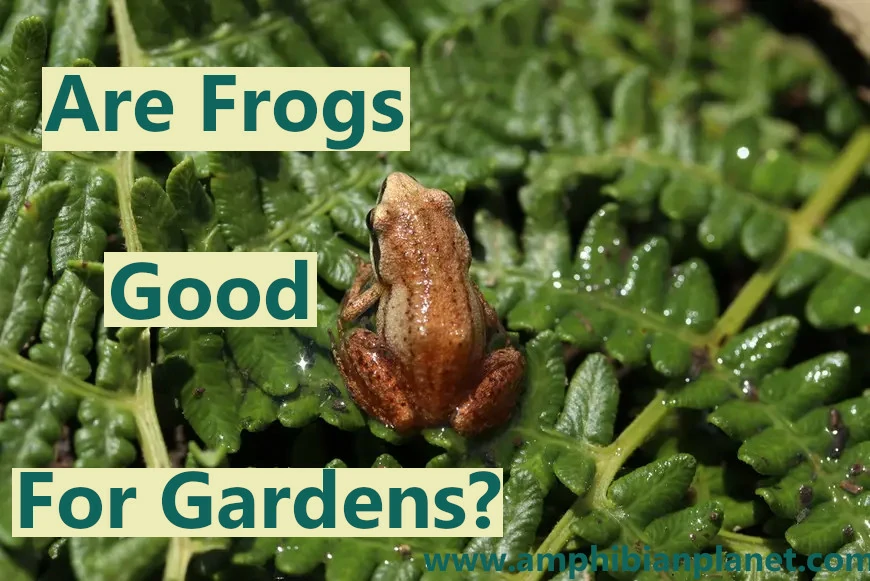Frogs are amphibians that love wet moist environments. For this reason, they are often attracted to gardens. Even watering your lawn can attract any frogs that may be close by. But do you have to be worried about frogs that are attracted to your garden?
In general, frogs are good to have in a garden. They eat many slugs, snails, and many pest insects, eliminating the need for pest repellent -and are also great bio-indicators that can tell you about the health of your garden ecosystem.
Having frogs in your garden can reduce pest problems, without the need for pesticides.
Frogs Are Generally Good for Gardens
Native frogs and toads can be beneficial for your garden.
Having frogs in your garden is a great sign that you have a clean, thriving, and healthy garden ecosystem.
1. Natural Pest Control
Most frogs are obligate carnivores as adults. This means they will not eat your garden plants but will eat grasshoppers, snails, slugs, and other pests that do.
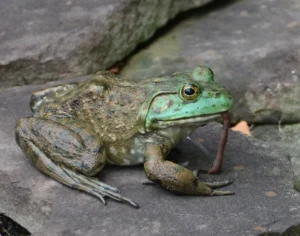
As earlier mentioned, frogs can be a natural form of pest control, without the need for pesticides.
In addition, frogs are prey for many animals such as snakes and predatory birds, so having frogs in your garden can also attract these animals, helping to eliminate pests, like rats, mice, and voles.
While it may seem like having snakes around is not a good thing, it’s important to note that not all snakes are bad to have around.
Some snake species such as garter snakes and rat snakes are generally harmless to humans and eat pests such as rodents and slugs.s
Kingsnakes (which are also harmless to humans) are even known to eat venomous snakes such as copperheads and rattlesnakes – helping keep these away these potentially harmful snakes.
2. Bioindicators
Frogs are great bio-indicators that can tell you about the health of your garden ecosystem.
Frogs have thin, highly permeable skin and are very sensitive to pollution. Having frogs in your garden is a great sign that you have a clean, thriving, and healthy garden ecosystem.
They can’t live in polluted habitats and are sensitive to changes in their environment, so the presence of frogs or toads is a sign the habitat is healthy.
A sudden change in their presence can show that your garden has become polluted, or is unbalanced.
3. Nutrient Recycling
Most frogs have a life cycle that starts in the water. When they lat their eggs in garden ponds, these eggs hatch into tadpoles.
These tadpoles feed on algae and decaying organic matter, effectively recycling nutrients in the water.
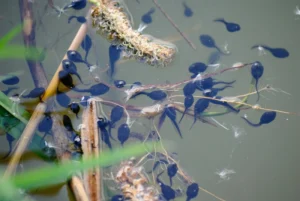
As they grow, they metamorphose into adult frogs and venture onto land. But the nutrient cycling doesn’t stop there. Frogs, through their droppings, contribute to the nutrient content of the soil, acting as natural fertilizers for your plants.
4. Pollination
Bees and other insects are often associated with pollination. However, frogs can also play a role in this process.
Many tree frog species may climb on flowers, and as they move from flower to flower, they inadvertently transfer pollen, aiding in the fertilization of plants.
This partnership can be an essential aspect of a garden’s reproductive cycle.
5. Visual Appeal
Frogs increase the overall enjoyability of your garden.
Birds, butterflies, and ladybugs can be great to watch as they come to your garden. Frogs and toads can be great fun to watch and listen to when the different species start calling for mates.
6. Conservation
Research suggests that amphibians are severely declining worldwide.
Having frogs in your garden means you are providing a home for them, contributing to frog conservation.
9 Tips to Attract Frogs to Your Garden
By attracting frogs to your garden, you’re not just creating a picturesque scene, but also promoting a balanced and thriving environment.
In short words, the easiest way to attract frogs to a garden is to replicate their natural habitat.
Here are 9 tips to help you attract frogs to your Garden.
1. Reduce the Use of Chemical Pesticides
Frogs and other amphibians have unique skin compared to that of many other vertebrates. Their skin is composed of thin membranous tissue that is quite permeable to water and contains a large network of blood vessels.
This permeable skin distinguishes them from mammals, birds, or reptiles.
Permeability relates to how easily a gas or liquid molecule can pass back and forth from the environment into the animal and vice versa.
Typically, the larger the molecule, the more difficult it is to enter the animal through its skin. Amphibian skin is more permeable than that of other vertebrates.
Their membranous skin allows water and respiratory gases to readily diffuse directly down their gradients between the blood vessels and the surroundings.
Chemical pesticides can penetrate frogs’ skin and cause harm.
Opt for natural pest control methods, like introducing beneficial insects or using organic sprays. This not only protects the frogs but also maintains a healthier garden overall.
2. Create a Garden Pond
Frogs are amphibians and require a water source for breeding and hydration.
A small well-designed pond, or even a shallow container just a few feet deep, with clean water, can attract frogs to your garden.
It’s important to ensure that the water is free of chlorine or any pesticides and has a gentle slope so frogs and toads can easily get in and out of it.
Surround the water with native plants, as they provide shelter, and attract insects that frogs feed on.
3. Use Native Plant Species
A diverse range of plants is essential for a frog-friendly garden. Apart from their visual appeal, plants offer multiple benefits. They provide shade, which helps regulate the temperature. This is crucial for frogs, as they are ectothermic creatures.
Aim for a diverse range of plants, including grasses, shrubs, and trees, to create a balanced ecosystem.
4. Regularly Water Your Garden
Frogs have permeable membranous skin, which they use to breathe (in addition to breathing using their lungs).
To efficiently breathe via their skin, frogs have to keep their skin constantly moist by secreting a special mucous coating (which gives them a slimy feeling when touched).
If a frog’s skin dries up, it can suffocate and die.
For this reason, frogs generally need to live in damp environments where they can keep their skin moist, and prevent it from drying out.
Regularly water your garden, especially during dry spells, to maintain the moisture levels.
Mulching can also help retain moisture and provide additional hiding spots for frogs.
5. Create Hiding Spots for Frogs
Frogs like to seek out hiding spots during the day to avoid predators and extreme temperatures.
Incorporate various elements, like rocks, logs, and dense vegetation into your garden.
By offering a range of hiding spots, you’re ensuring that frogs feel safe and comfortable in your garden.
6. Create Basking Areas
Frogs often bask in the sun to warm up their bodies. Create open areas in your garden where frogs can bask.
Flat logs or large rocks can work well for this purpose.
7. Avoid Excessive Artificial Lighting
Most frogs are nocturnal, so excessive artificial lighting can disrupt their natural behavior.
Opt for low-intensity warm, lights as they are less likely to disturb the natural rhythms of frogs. The lights also attract insects, creating a buffet frog frogs.
8. If You Have Fish in Your Garden Pond, Create a Separate Area for Frogs
People often stock their garden ponds with fish.
While fish may seem harmless, they can prey on frog eggs and tadpoles.
Large frog species, such as bullfrogs, are also known to prey on small fish.
If you have fish in your garden pond, consider creating a separate area for frogs.
9. Prevent Pets From Accessing Your Garden
Some pets, such as dogs, and cats can be a threat to frogs.
If you have any pets, ensure your garden has barriers, like fences or hedges, to prevent access.
Sometimes, Frogs May Not Be Good for a Garden
Although frogs are generally good for gardens, there are some situations in which having frogs in your garden may not be all positive.
1. Frogs May Attract Venomous Snakes
Worldwide, many snakes primarily feed on small amphibians and rodents. For example, in North America, the primary food of the eastern hognose snake is toads.
Garter snakes are also heavily reliant on frogs, toads, salamanders, and newts as food. Asian Keelback snakes also very frequently eat frogs and their tadpoles.
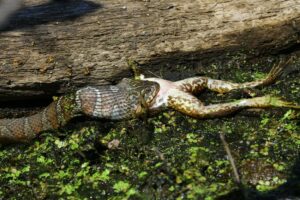
There are even snakes that specialize in eating frog egg masses laid on leaves overhanging streams.
For this reason, snakes will be attracted to areas where they can find lots of frogs, rodents, and other small animals to prey on.
Although many snake species are not harmful to humans, frogs can also attract venomous snakes, such as rattlesnakes.
2. Some Frogs Produce Toxic Skin Secretions
Some frog species, such as Pickerel frogs, and Cuban tree frogs produce toxic skin secretions as a defense against predators.
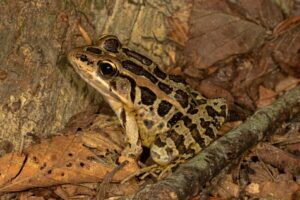
These secretions can be very irritating when they come in contact with your eyes and mucous membranes.
They are also irritating to dogs or cats that ingest it via the mouth or eyes.
That said, it’s important to note that even poisonous frogs typically aren’t dangerous to humans. The only danger comes when their toxic secretions are ingested.
The toxin is not absorbed through your skin but can be absorbed through breaks or cuts on the skin, and the mucous membranes in your eyes, nose, or mouth.
This can happen when you pick up a frog with your bare hands, then rub your eyes, or stick your fingers in your nose or mouth without first washing your hands.
Doing this would enable the toxin to be absorbed by your mucus membranes and likely lead to strong irritation and general discomfort.
For this reason, it is a good idea to wash your hands thoroughly after handling any frogs.
3. Frogs Often Carry Salmonella
Almost all amphibians can carry bacteria that can make humans sick. One important bacteria is salmonella.
Frogs can carry salmonella bacteria in their intestinal tract and continually pass them off in their waste.

The bacteria usually do not cause any illness in the frog – so a frog carrying salmonella bacteria can look very clean and healthy, but the bacteria can be transmitted to humans.
You can be exposed through either direct or indirect contact with the frog its droppings, or anything the frog came in contact with. (For example, if you touch a frog, it is droppings or water where the frog has been, then stick your fingers into your mouth without first washing your hands).
Exposure to salmonella can lead to an illness known as salmonellosis which is characterized by diarrhea, fever, and abdominal cramps.
Most infections only cause mild illness, but sometimes, the bacteria can spread to the bloodstream leading to serious illness.
Fortunately, you won’t get sick by simply touching a frog. The bacteria can only cause illness when they are ingested.
Therefore, thoroughly washing your hands with anti-bacterial soap immediately after touching a frog should keep you out of harm’s way.
Conclusion
Remember, creating a frog-friendly space is not only about attracting them but also providing a sustainable habitat.
So, roll up your sleeves and get creative.

